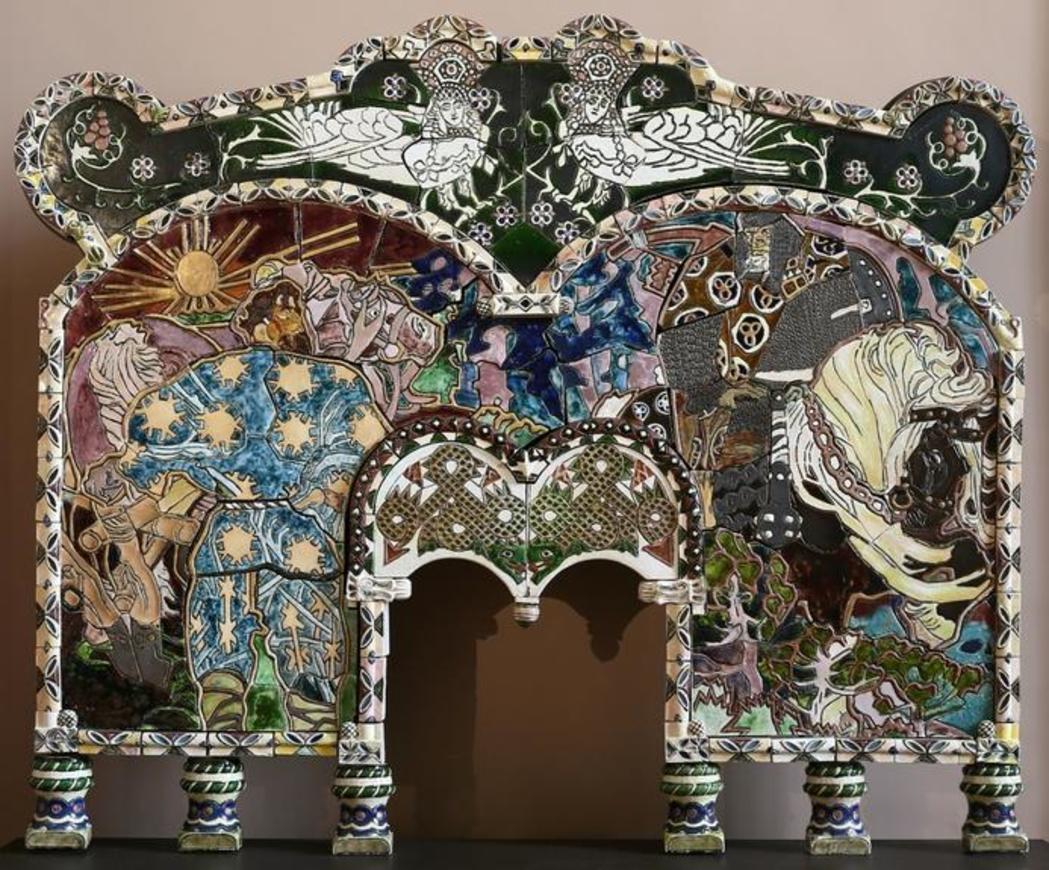To answer these questions, there was a single solution: to try to recreate the original work. All the pieces were laid out and assembled as they went along. This painstaking work revealed a large semi-circular decoration, developed around a hollowed-out middle. It was shaped like a mantelpiece, with the hearth in the centre. The decoration is truly spectacular. To the right, appears a man in armour holding a club. Behind him, a fiery steed (horse) shakes his mane. To the right, a massive peasant in a star-spangled suit firmly holds his plough and mare, under a shining sun. On either side, they are surrounded by two birds with women's heads, with their hair in a traditional Russian style, along with two snakes facing one another.
The theme illustrates the legend (bylina, in Russia) of the warrior Volga and the labourer Mikouli, celebrating the victory of the Russian peasants over the aristocracy. At the bottom left, the artist has signed his work: M. Vroubel, for Mikhaïl Vroubel.
This artist was chosen to represent Russia in the country's pavilion at the 1900 Paris Exposition. The mantel, placed in the centre of a traditional isba (house), is topped with a gold medal.
It was then brought back to the Lille Palais des Beaux-Arts to complete the collection of Art Nouveau ceramics. But, in the 1960s, perhaps for reasons of fashion and in order to make space, Vroubel's mantel was dismantled and placed in a crate. After four years of study, restoration and mounting, the mantel once again recounts the legend of Volga and Mikoula.

To answer these questions, there was a single solution: to try to recreate the original work. All the pieces were laid out and assembled as they went along. This painstaking work revealed a large semi-circular decoration, developed around a hollowed-out middle. It was shaped like a mantelpiece, with the hearth in the centre. The decoration is truly spectacular. To the right, appears a man in armour holding a club. Behind him, a fiery steed (horse) shakes his mane. To the right, a massive peasant in a star-spangled suit firmly holds his plough and mare, under a shining sun. On either side, they are surrounded by two birds with women's heads, with their hair in a traditional Russian style, along with two snakes facing one another.
The theme illustrates the legend (bylina, in Russia) of the warrior Volga and the labourer Mikouli, celebrating the victory of the Russian peasants over the aristocracy. At the bottom left, the artist has signed his work: M. Vroubel, for Mikhaïl Vroubel.
This artist was chosen to represent Russia in the country's pavilion at the 1900 Paris Exposition. The mantel, placed in the centre of a traditional isba (house), is topped with a gold medal.
It was then brought back to the Lille Palais des Beaux-Arts to complete the collection of Art Nouveau ceramics. But, in the 1960s, perhaps for reasons of fashion and in order to make space, Vroubel's mantel was dismantled and placed in a crate. After four years of study, restoration and mounting, the mantel once again recounts the legend of Volga and Mikoula.